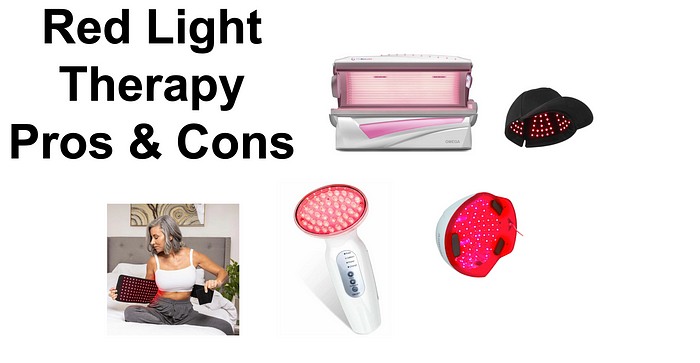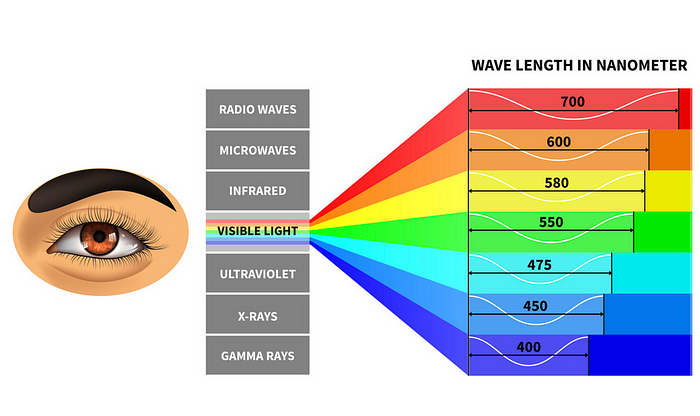The Pros and Cons to using Red Light Therapy

Red light therapy has grown in popularity recently.
The Kardashians, Kate Hudson, and Jessica Alba share how they use these products for the benefits it affords to skin health. However, the effects of using Red Light Therapy products is still being researched.
In this article I will outline:
- How Red Light Therapy Works
- The Pros and Cons of Using Red Light Therapy
How Red Light Therapy Works
The scientific term that describes Red Light Therapy is Photobiomodulation. The term Photobiomodulation more accurately describes the process of Red Light Therapy if you break the word down into individual parts (Photo — Bio — Modulation):
- Photo — is another word for light. Light is made up of different particles called Photons.
- Bio — this term refers to living cells.
- Modulation — the definition for this term means: to exert influence on or to modify.
The process behind red light therapy is light modulating (modifying) or living cells. It’s a process that we see in plants when they convert light into energy (also known as Photosynthesis).
Red light therapy uses LED light bulbs that are similar to what you might buy for your home. However, these LED light bulbs produce light at a frequency that is near the infrared light spectrum:

If you remember High School physics class, you might remember the above photo of the light spectrum. The LED Light Bulbs used in Red Light Therapy produces light that is still visible, but near the infrared light spectrum (typically, the highest it goes is 1080 Nanometers).
This range of light has shown positive results of stimulating cell activity.
Pros and Cons of Using Light Therapy
Red light therapy offers many promising benefits:
Pros: Skin Health — there have been a few studies that show promising benefits of using red light devices to help with common skin issues:
- One study found that red light therapy can improve the appearance of fine lines and wrinkles, as well as increase collagen production. The study used a device that emitted red and infrared light, and participants who used the device for 8 weeks saw an improvement in skin elasticity, texture, and overall appearance.
- Another study found that red light therapy can reduce the symptoms of psoriasis, a chronic skin condition that causes red, scaly patches on the skin. The study used a device that emitted red and near-infrared light, and participants who used the device for 12 weeks saw a significant reduction in the severity of their psoriasis symptoms.
- A small-scale study has also shown that red light therapy can help to improve eczema symptoms. The study found that participants who received red light therapy had an improvement in skin hydration, a reduction in skin itching and a decrease in the severity of eczema symptoms.
Pros: Memory Loss — Another area that red light therapy can assist is with individuals who suffer from memory loss. Memory loss is common with individuals who have dementia and Alzheimer's disease. Additionally, athletes who suffer from concussions are at a high risk of memory loss later in life.
- One study showed that individuals who suffered from early on-set dementia improved their ability to function when they wore a Red Light helmet compared to a control group who used a placebo helmet.
Unfortunately, while all of these areas show promise there are a few notable downsides:
Cons: Limited scientific research — if you take one Google Search today for the term ‘Red light therapy’ you will find that there are many organizations willing to sell you devices, but they don’t engage in the research of the field that their devices actually work. To date, there isn’t a single Red Light Therapy device that has FDA clearance for medical use.
Cons: Red light therapy can cause some health risks:
- One study found that prolonged exposure to red light can lead to retinal damage in rats. The study found that rats that were exposed to red light for long periods of time had a significant increase in the number of cells that had died in the retina, compared to control rats that were not exposed to red light.
- Another study found that prolonged exposure to red light can lead to an increase in oxidative stress in the eyes. The study found that rats that were exposed to red light for long periods of time had an increase in markers of oxidative stress, such as lipid peroxidation and protein oxidation, in the eyes.
- A review of literature from 2018, has also suggested that excessive exposure to red light may cause damage to the eyes and can even cause retinal degeneration in animals.
It is important to note that these studies were conducted on animals and more research is needed to fully understand the potential risks of excessive red light exposure in humans. However, it is always recommended to wear protective eye wear during red light therapy treatment to avoid any potential risks.
